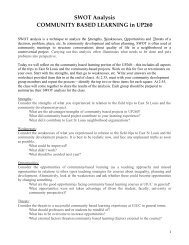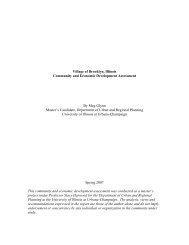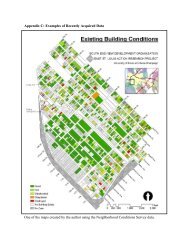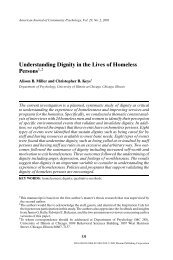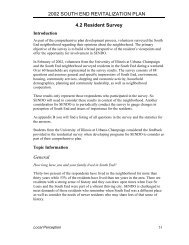Approaches to Homelessness Policy in Europe, the United States ...
Approaches to Homelessness Policy in Europe, the United States ...
Approaches to Homelessness Policy in Europe, the United States ...
You also want an ePaper? Increase the reach of your titles
YUMPU automatically turns print PDFs into web optimized ePapers that Google loves.
642 M<strong>in</strong>nery and Greenhalghof its prevalence. This is one of <strong>the</strong> ways <strong>in</strong> which a clear connection can bemade between research and policy. It is also helpful for policy-makers <strong>to</strong> have asatisfac<strong>to</strong>ry concept of what constitutes “good practice” <strong>in</strong> homelessness policies.An understand<strong>in</strong>g of <strong>the</strong> policies <strong>in</strong> place <strong>in</strong> o<strong>the</strong>r relevant countries and of how<strong>the</strong>y are implemented supports both <strong>the</strong>se goals.This article reports on a project that reviewed approaches <strong>to</strong> homelessnesspolicy, and updates and extends an earlier basel<strong>in</strong>e study completed <strong>in</strong> 1998 (Manicaros& Lanyon, 1999). The project compared approaches taken <strong>in</strong> Australia withthose <strong>in</strong> <strong>the</strong> U.S., <strong>the</strong> U.K., and <strong>the</strong> <strong>Europe</strong>an Union (E.U.) member states as a wayof advis<strong>in</strong>g <strong>the</strong> Australian Government, and particularly its Supported AccommodationAssistance Program (<strong>the</strong> pr<strong>in</strong>cipal program through which national-levelfund<strong>in</strong>g <strong>to</strong> address homelessness is made available) on <strong>the</strong> current state of homelessnesspolicies. The <strong>in</strong>vestigation explored def<strong>in</strong>itions and concepts of homelessnessand whe<strong>the</strong>r <strong>the</strong>y had changed s<strong>in</strong>ce 1998, <strong>the</strong> changes <strong>to</strong> legislation andpolicy over that period, and analyzed what could be considered good practice <strong>in</strong>alleviat<strong>in</strong>g homelessness.The research was completed <strong>in</strong> early 2003 (see Greenhalgh, Miller, Mead,Jerome, & M<strong>in</strong>nery, 2004), but for <strong>the</strong> current article some of <strong>the</strong> more recentpolicy literature has been <strong>in</strong>cluded or previous references updated. The scope of<strong>the</strong> review is limited <strong>to</strong> literature about policies and applied social policy documents<strong>in</strong> <strong>the</strong> English language, but <strong>in</strong>cludes publications from government agenciesand nongovernment organizations as well as <strong>the</strong> available academic and researchliterature.The aim of this article is <strong>to</strong> provide an overview of <strong>the</strong> ma<strong>in</strong> issues <strong>to</strong> emergefrom <strong>the</strong> review and <strong>to</strong> compare recent advances <strong>in</strong> <strong>the</strong> homelessness debate and <strong>in</strong>policy responses with <strong>the</strong> expectations emerg<strong>in</strong>g from ideas about “good practice.”Although such a comparative overview can be helpful <strong>in</strong> identify<strong>in</strong>g problems andpotential solutions <strong>in</strong> any arena of substantive policy concern, <strong>the</strong> <strong>in</strong>terpretationof specific policy approaches <strong>to</strong> homelessness needs <strong>to</strong> be seen with<strong>in</strong> a widersocial policy framework. The major differences between <strong>the</strong> Australian and U.S.policy environments and how <strong>the</strong>se might impact on policies concern<strong>in</strong>g AIDS riskbehavior among homeless youth, for example, is clearly identified by Milburn andher colleagues (2007). The complexities of <strong>the</strong> overarch<strong>in</strong>g policy environments of<strong>the</strong> different countries referred <strong>to</strong> <strong>in</strong> this article are not canvassed, but none<strong>the</strong>less<strong>the</strong> overview does identify some important policy approaches and po<strong>in</strong>ts <strong>to</strong> somepolicy-related research gaps.<strong>Homelessness</strong>: Recent ConceptualizationsAs identified <strong>in</strong> o<strong>the</strong>r contributions <strong>in</strong> this issue, ideas about homelessness—what it is, what leads people <strong>to</strong> homelessness, who constitute <strong>the</strong> homeless, andwhat k<strong>in</strong>ds of policy response are most effective—have been <strong>the</strong> focus of considerableand ongo<strong>in</strong>g debate. Although a number of different views of homelessness



